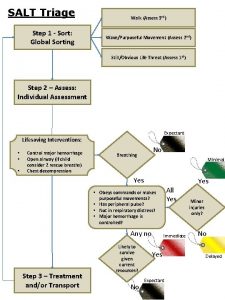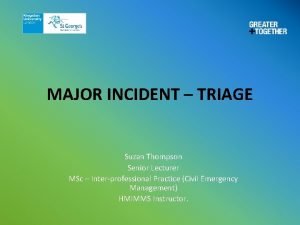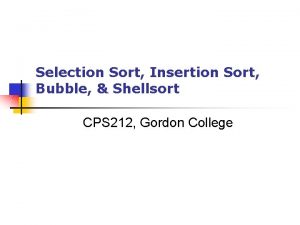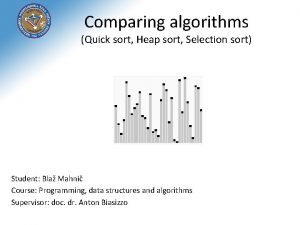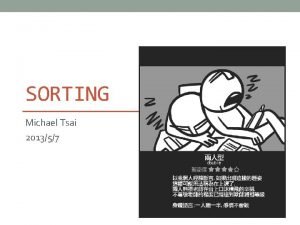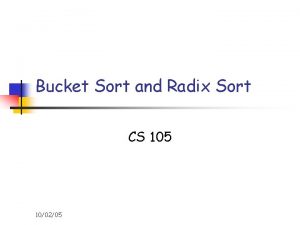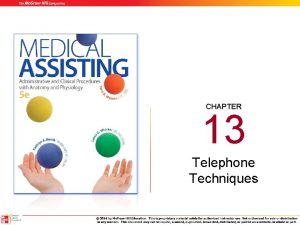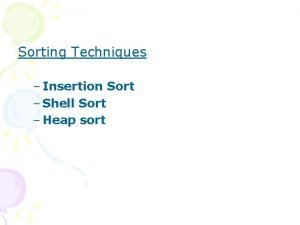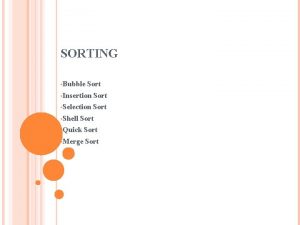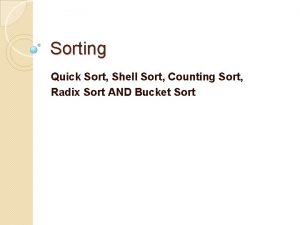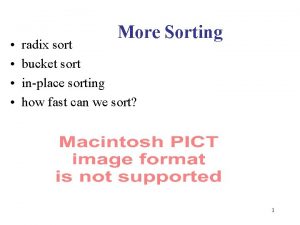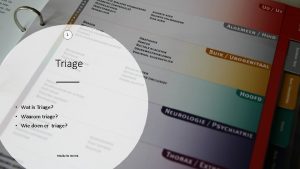Triage To Sort Triage A process for sorting








































- Slides: 40

Triage “To Sort”

Triage A process for sorting injured people into groups based on their need for or likely benefit from immediate medical treatment. Triage is used in hospital emergency rooms, on battlefields, and at disaster sites when limited medical resources must be allocated.

METTAG Color Code the Victims This tag identifies the medical treatment and transportation priority of patients.

METTAG Color Code the Victims Green is the lowest priority and is used for walking wounded or patients who may not need to go to hospital. They can wait for treatment and/or transport until all other patients have been moved from the scene.

METTAG Color Code the Victims Yellow is used for patients who definitely need to go to a hospital, but not immediately. These patients have injuries that are serious but not life-threatening, such as burns without airway problems, major or multiple bone

METTAG Color Code the Victims or joint injuries, and back injuries without spinal cord damage. These patients will be treated and transported after the critical (or red tagged) patients have been taken to trauma centers or hospitals.

METTAG Color Code the Victims Red is used for critically-injured patients with treatable life-threatening injuries. This might include airway and breathing difficulities, decreased mental status, and uncontrolled bleeding. The patients will be transported from the scene first.

METTAG Color Code the Victims Black is used for dead and unsalvageable patients such as someone in cardiac arrest. These victims will be removed from the scene, but only after all the living/salvageable patients.

METTAG Color Code the Victims After assessing a patient’s need, you place the METTAG over his head (around the neck) and tear off the perforated tag(s) at the bottom. The color left at the very bottom is the patient’s triage identification.

START Simple Triage And Rapid Treatment START is a triage system that is simple and fast, requiring less than sixty seconds for each patient. The system provides for rapid life saving stabilization such as airway control and bleeding control.

START Simple Triage And Rapid Treatment START excludes CPR ! CPR is not performed in these situations because two or three rescuers would be required to treat a single patient whose probability of survival is zero-to-none. On the other hand, those same two or three rescuers can treat five, ten, or maybe more patients.

START Simple Triage And Rapid Treatment First Anyone who gets up and walks to the designated areas is given a green tag (may not even require hospital care)

START Simple Triage And Rapid Treatment Second Anyone who is not breathing is given a black tag (dead / non-salvageable)

START Simple Triage And Rapid Treatment Third Anyone who fails one of the RPM assessments is given a red tag (critical / immediate) R = Respiration P = Perfusion M = Mentation

START Simple Triage And Rapid Treatment Third RPM R = Respiration P = Perfusion M = Mental Status

START Simple Triage And Rapid Treatment Third RPM R = Respiration What is the rate of breathing? Above 30 breaths per minute the patient needs immediate care

START Simple Triage And Rapid Treatment Third RPM R = Respiration What is the rate of breathing? If less than 30 breaths per minute, move on to the next part of assessment.

START Simple Triage And Rapid Treatment Third RPM P = Perfusion Check for the presence of radial pulse (located on the thumb side of the wrist) If no pulse patient needs immediate care

START Simple Triage And Rapid Treatment Third RPM P = Perfusion Check for the presence of radial pulse (located on the thumb side of the wrist) If pulse is present, move onto the next assessment.

START Simple Triage And Rapid Treatment Third RPM M = Mental Status A patient who is unconscious or conscious but unable to follow directions requires immediate care

START Simple Triage And Rapid Treatment Third RPM M = Mental Status A patient who is conscious and can follow directions is given a yellow tag

START Simple Triage And Rapid Treatment Fourth Anyone who cannot walk but passes all of the assessments is given a yellow tag (delayed).

START Simple Triage And Rapid Treatment

Triage Exercises

Triage Exercise 1 • Your victim has a compound facture, of the left femur. • Respirations are over 30/min. • Radial pulse absent. • Awake • R-Respirations 30 • P-Radial pulse • M-Mental status • • [] Deceased [] Immediate [] Delayed [] Minor

Triage Exercise 1 • Your victim has a compound facture, of the left femur. • Respirations are over 30/min. • Radial pulse absent. • Awake • R-Respirations 30 • P-Radial pulse • M-Mental status • • [] Immediate • •

Triage Exercise 2 • A woman with sudden onset of chest pain with shortness of breath • Respirations are under 30/min. • Radial pulse present. • Awake • R-Respirations 30 • P-Radial pulse • M-Mental status • • [] Deceased [] Immediate [] Delayed [] Minor

Triage Exercise 2 • A woman with sudden onset of chest pain with shortness of breath • Respirations are under 30/min. • Radial pulse present. • Awake • R-Respirations 30 • P-Radial pulse • M-Mental status • • [] Minor

Triage Exercise 3 • A man with 90% of his body with second degree burns • Respirations none • Radial pulse present. • Unconscious • R-Respirations 30 • P-Radial pulse • M-Mental status • • [] Deceased [] Immediate [] Delayed [] Minor

Triage Exercise 3 • A man with 90% of his body with second degree burns • Respirations none • Radial pulse present. • Unconscious • R-Respirations 30 • P-Radial pulse • M-Mental status • [] Deceased • • •

Triage Exercise 4 • A student has a bruise on their forehead, blood in the ears and nose • Respirations are under 30 • Radial pulse present. • Unconscious • R-Respirations 30 • P-Radial pulse • M-Mental status • • [] Deceased [] Immediate [] Delayed [] Minor

Triage Exercise 4 • A student has a bruise on their forehead, blood in the ears and nose • Respirations are under 30 • Radial pulse present. • Unconscious • R-Respirations 30 • P-Radial pulse • M-Mental status • • [] Immediate • •

Triage Exercise 5 • Impaled, 1 foot piece of shrapnel in right eye • Respirations are under 30 • Radial pulse present. • Awake, alert and orientated • R-Respirations 30 • P-Radial pulse • M-Mental status • • [] Deceased [] Immediate [] Delayed [] Minor

Triage Exercise 5 • Impaled, 1 foot piece of shrapnel in right eye • Respirations are under 30 • Radial pulse present. • Awake, alert and orientated • R-Respirations 30 • P-Radial pulse • M-Mental status • • • [] Delayed •

Triage Exercise 6 • A child with server difficulty breathing, chest sinks in on inspiration • Respirations over 30 • Radial pulse present. • Awake • R-Respirations 30 • P-Radial pulse • M-Mental status • • [] Deceased [] Immediate [] Delayed [] Minor

Triage Exercise 6 • A child with server difficulty breathing, chest sinks in on inspiration • Respirations over 30 • Radial pulse present. • Awake • R-Respirations 30 • P-Radial pulse • M-Mental status • • [] Immediate • •

Triage Exercise 7 • A girl who is saying the same words over and over, “What happened? ” • Respirations under 30 • Radial pulse present. • Awake, but not orientated • R-Respirations 30 • P-Radial pulse • M-Mental status • • [] Deceased [] Immediate [] Delayed [] Minor

Triage Exercise 7 • A girl who is saying the same words over and over, “What happened? ” • Respirations under 30 • Radial pulse present. • Awake, but not orientated • R-Respirations 30 • P-Radial pulse • M-Mental status • • [] Immediate • •

Triage Exercise 8 • Bruising over abdomen, complaining of abdominal pain • Respirations over 30 • Radial pulse present. • Awake • R-Respirations 30 • P-Radial pulse • M-Mental status • • [] Deceased [] Immediate [] Delayed [] Minor

Triage Exercise 8 • Bruising over abdomen, complaining of abdominal pain • Respirations over 30 • Radial pulse present. • Awake • R-Respirations 30 • P-Radial pulse • M-Mental status • • [] Immediate • •
 Internal sorting and external sorting
Internal sorting and external sorting Salt triage
Salt triage Lesson 2 assignment a sort of sorts answers
Lesson 2 assignment a sort of sorts answers Rpm triage
Rpm triage Ingangsklacht betekenis
Ingangsklacht betekenis Triage sort
Triage sort Naru triage sort
Naru triage sort Triagehandboken
Triagehandboken Triage sort
Triage sort Bubble sort vs selection sort
Bubble sort vs selection sort Difference between selection sort and bubble sort
Difference between selection sort and bubble sort Annyt
Annyt How selection sort works
How selection sort works 排序
排序 Selection sort vs heap sort
Selection sort vs heap sort Selection sort vs bubble sort
Selection sort vs bubble sort Quick sort merge sort
Quick sort merge sort Quick sort merge sort
Quick sort merge sort Radix sort vs bucket sort
Radix sort vs bucket sort Radix bucket sort
Radix bucket sort Define a routing list as it pertains to incoming calls
Define a routing list as it pertains to incoming calls Customer request triage
Customer request triage Kontinuitetshantering
Kontinuitetshantering Novell typiska drag
Novell typiska drag Nationell inriktning för artificiell intelligens
Nationell inriktning för artificiell intelligens Returpilarna
Returpilarna Varför kallas perioden 1918-1939 för mellankrigstiden?
Varför kallas perioden 1918-1939 för mellankrigstiden? En lathund för arbete med kontinuitetshantering
En lathund för arbete med kontinuitetshantering Särskild löneskatt för pensionskostnader
Särskild löneskatt för pensionskostnader Tidbok
Tidbok Anatomi organ reproduksi
Anatomi organ reproduksi Förklara densitet för barn
Förklara densitet för barn Datorkunskap för nybörjare
Datorkunskap för nybörjare Stig kerman
Stig kerman Debattartikel mall
Debattartikel mall Delegerande ledarstil
Delegerande ledarstil Nyckelkompetenser för livslångt lärande
Nyckelkompetenser för livslångt lärande Påbyggnader för flakfordon
Påbyggnader för flakfordon Tryck formel
Tryck formel Publik sektor
Publik sektor I gullregnens månad
I gullregnens månad

